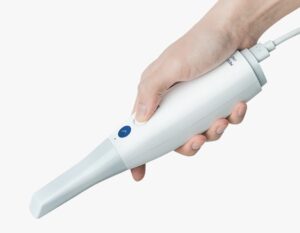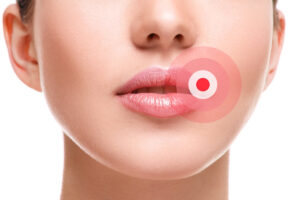
As a dentist in Shelby Township for over 25 years, I have always been committed to the highest standards of dentistry. This commitment is supported by advanced training and incorporating advanced technology into our dental office. This culminates into optimal care for our patients, providing exceptional results to support the health and appearance of every smile.
Although we are widely known for patient comfort, all stages of dental implants, unsurpassed outcomes in cosmetic dentistry and advanced skills in jaw joint disorders, we also have a reputation for gum re-contouring, which typically involves the use of a dental laser.
Our Nd: YAG Laser comes with many benefits for patients for a wide variety of needs. This small, hand-held device is a tremendous asset when it comes to both the health and appearance of gum tissues. Not only does the laser eliminate or greatly minimize bleeding during procedures, it can reduce numbing requirements, remove bacteria and easily uncover gum tissue where dental implants have been placed. Because a laser can seal gum tissues as it goes, patient comfort is enhanced, and healing time is faster.
A dental laser can also be a significant tool in enhancing the appearance of a smile. While the shape, shade and length of teeth have a major impact on the appearance of a smile, the uniformity of gum tissues are a factor as well. The balance of gums to teeth greatly affects a smile’s appearance by providing a proper ‘framework’ of gum tissue.
As a general and neuromuscular dentist, I also use a dental laser to repair gum recession. When gum tissues pull away from the base of teeth, the tight seal they are intended to provide, which occurs for reasons that include:
• Poor dental hygiene – When brushing, flossing, and rinsing are insufficient to rid the mouth of bacteria, their accumulation can result in plaque. This is the sticky film you feel on teeth. In just a few days, plaque can harden into tartar. This is a hardened bacterial colony that attaches onto and between teeth. Once formed, brushing or flossing cannot remove tartar. It can only be removed during a professional tooth cleaning. If not removed, teeth, gums and the structures below the gum line can be damaged.
• Periodontal (gum) disease – Caused by bacteria, gum disease destroys oral tissues and the bone that supports natural tooth roots. Once active, gum disease will only progress without treatment, eventually evolving to the advanced stage known as periodontitis. In this, tooth loss is likely to occur. In addition to receded gums, signs of periodontal disease include gums that turn red or purple, tender or swollen gums, seeing blood in the sink when brushing and persistent bad breath.
• Brushing too hard – If you brush your teeth too aggressively or use a hard bristled toothbrush, it can wear away tooth enamel and cause the gums to recede.
• Aging – As people age, their gums become drier. This causes them to shrink and be less capable of keeping a secure grip around the base of teeth.
• Hormones – During the changes in estrogen levels that females experience (puberty, menstrual periods, pregnancy, menopause), the gums can be more sensitive and vulnerable to gum recession.
• Smoking/Vaping – In addition to the many health hazards that smokers face, they are more likely to develop plaque which can lead to gum recession.
• Bite misalignment – When teeth don’t come together evenly, too much force can be exerted on the gums and surrounding bone, allowing gums to recede. Bite misalignment can also lead to grinding or clenching teeth. These harsh forces on teeth can cause the gums to loosen their grip.
Some people may not realize they have experienced gum recession until a jolt of pain hits. This typically occurs when drinking or eating something cold or hot comes in contact with the receded area. Darker segments of the tooth may also be exposed, which are highly vulnerable to oral bacteria. The bacteria of gum disease can damage the structures that support natural teeth. Gum disease is the leading cause of adult tooth loss.
Gum recession should be repaired sooner than later with the problem halted from recurring. To do this, we begin by determining why the gum recession is occurring. The next step is to restore the gums to their proper positions. For this, a dental laser does an ideal job.
 A dental laser is also ideal for rapid healing of canker and cold sores (which can last up to 2 weeks). Through laser therapy, the progression of canker sores can be halted and the discomfort greatly reduced within a day or two. Tingling or burning sensation is the first sign that a cold sore is about to erupt. Cold sores repair fastest when laser treated when the very first symptom arises. Most patients notice significant improvement in comfort after laser treatment with a much shorter duration.
A dental laser is also ideal for rapid healing of canker and cold sores (which can last up to 2 weeks). Through laser therapy, the progression of canker sores can be halted and the discomfort greatly reduced within a day or two. Tingling or burning sensation is the first sign that a cold sore is about to erupt. Cold sores repair fastest when laser treated when the very first symptom arises. Most patients notice significant improvement in comfort after laser treatment with a much shorter duration.
Additionally, laser dentistry can correct a “gummy smile” with beautiful results. This is when a smile shows too much gum tissue above upper teeth when smiling fully. We correct this in a procedure known as crown lengthening. In this, a “gingivectomy” corrects the height of gum tissues so the smile has a more even smile line. This may involve the use of a dental laser, which provides a precision line and speeds healing.
Gum reshaping is recommended when certain teeth are bordered by more gum tissue than that which borders surrounding teeth. The procedure to correct this is crown lengthening, which is usually done in conjunction with crown placement. Known as crown lengthening, the procedure provides an appealing, balanced smile line that ‘frames’ each tooth with an arch similar to that over adjoining teeth. The procedure typically requires just one visit with minimal healing time. (Visit our Smile Gallery)
However, crown lengthening may also be performed to save a tooth from removal. For example, when a tooth has broken close to the gum line, crown lengthening procedures can remove gum tissue to expose more of the tooth. Because a tooth that breaks at the gum line must be removed, this procedure can expose sufficient tooth structure to support a crown.
Gingivectomies are performed while the patient is comfortably numbed. For some patients, sedation may be a preference for enhanced relaxation. Oral sedation is in pill form that allows patients to ‘doze’ through procedures. I.V. sedation, also known as ‘twilight sleep,’ is available for patients who prefer a deeper level of sedation.
When seeking out a Macomb County dental office, look for an environment of comfort and comprehensive care to enjoy confident smiles throughout your lifetime. To learn more about our dental services, technology and the environment of comfort we provide, call 586-739-2155 or tap here to schedule a free, private consultation appointment. New patients are always welcome!
You are also invited to get to know our dental office through this brief video: DrBarbatOfficeTour
If payment plans can help you achieve your smile goals, we offer several that require no down payment and interest-free. Learn more at: DrBarbatFinancialOptions